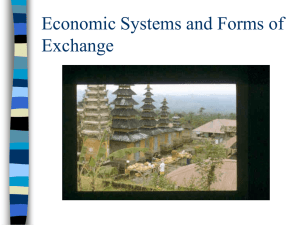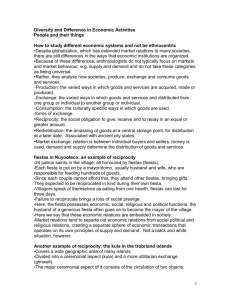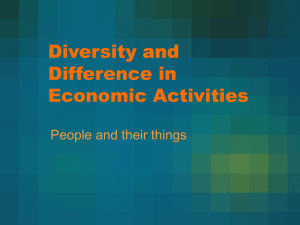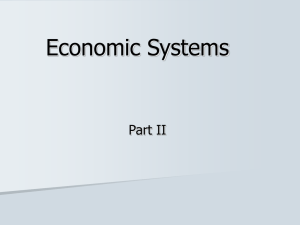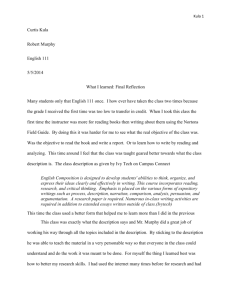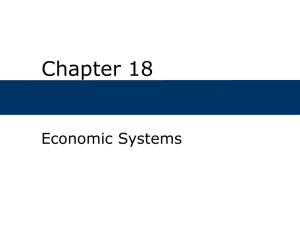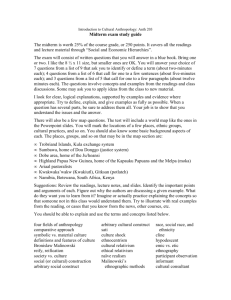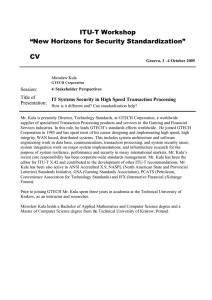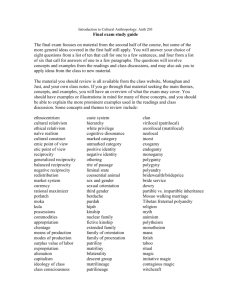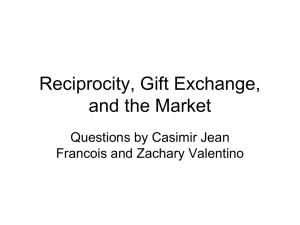Economic Systems and Forms of Exchange
advertisement
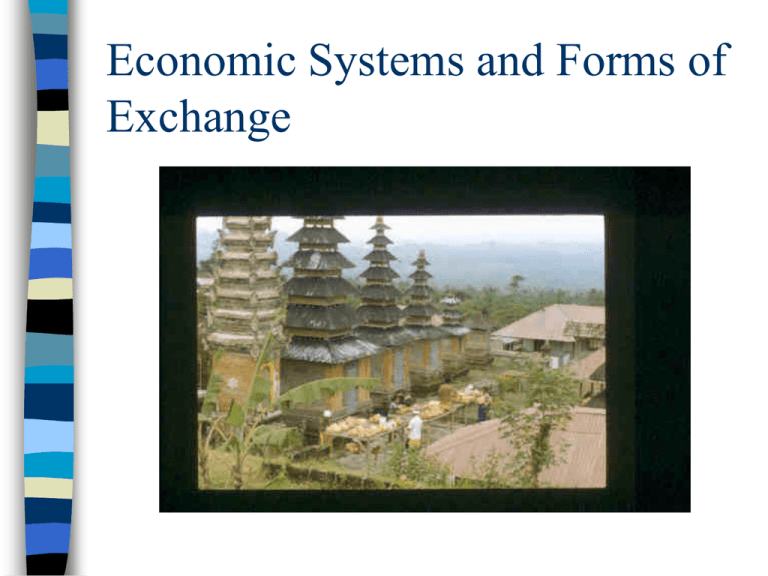
Economic Systems and Forms of Exchange Economic systems Production and allocation of material goods and services Do not operate independently of other aspects of society Especially closely associated with political systems which are concerned with the allocation of power and authority economic systems – three interrelated aspects Patterns of subsistence – the means by which environmental resources are converted for human use Systems of distribution – the means by which goods and services are made available to members of a particular group Patterns of consumption Non-Western Economic Systems Are there any? Anthropological approaches to the study of economic systems of production, distribution, and consumption The Formalist vs. Substantivist Debate The birth of economic anthropology Formalist Approach: the NeoClassical Toolkit Adam Smith (19th cent.) and the descriptive analytics of western capitalism Profit motive as human universal Maximizing utility Scarcity, cost/benefit, price Market governed by laws of supply and demand Rational economic behavior – human universal Marxism and Neo-Marxism Karl Marx (19th cent.) Marxist and Neo-Marxist approaches – How economic systems and economic relations sustain relations of power and control over labor – The “mode of production” • Means/Forces of production • Relations of production • Superstructure (ideology) The Substantivists’ and Marx’s modes of production Marx’s Modes of Production Emphasizes social relations & conflict within the system – The dialectic Emphasizes role of economy (a system of production, distribution, and consumption) in establishing and maintaining social relations Substantivist concern with the social embeddedness of the economy Substantivist Economic Theory formal neoclassical theory cannot be used to explain economic activities in non-western societies patterns of economic exchange must instead be interpreted within a society's cultural context rationality is culturally, not universally defined The Substantivist Approach Studying the cultural particulars of any group and economic system Economic maximization and cultural specificty – Economizing: the rational allocation of scarce means (or resources) to alternative ends (or uses) Socially embedded economy with other values than profit and maximization Idea of the “moral economy” the ways in which economic activities are influenced or constrained to some degree by moral considerations – even though these sometimes get compromised or overridden by other considerations Self-interest, power and expedience are not the only influences on economic life. Not only in the domestic sphere but in the formal economy, within organisations, in labour and product markets, moral sentiments and norms influence behaviour Patterns of Labor Sexual Division of Labor – Differentiation & integration – The basis of society Configurations of SDL – Flexibility – Rigid segregation & Dual Sex systems Dual Sex Patterns of Labor a dual-sex society in which both sexes are assigned their special responsibilities Women are a sexual class that has a common position with respect to another sexual class, males. a social relationship with each other – – – – partnership and cooperation division of tasks sexual relationships relationships of domination and oppression. complementary but at other times these two sexual classes are in opposition to each other. each class has a different set of interests, and women often have interests opposed to those of males. Patterns of Labor Age Division of Labor – Typical of human societies Cooperation – Household is the basic unit Craft Specialization – Found in both industrial and nonindustrial societies Control of Land All societies allocate land resources Food Foragers -- Where to hunt and gather Horticulturalists -- Distribution of farmland Pastoralists -- Water and grazing rights Industrial societies -- Private ownership prevails Nonindustrial societies -- Often controlled by kinship groups Technology Tools and other material equipment, together with the knowledge of how to make and use them The act of production Foragers and pastoralists generally have fewer and less complex tools than sedentary peoples Forms of Exchange (Polanyi) Formalist approach ignores some forms of exchange – Reciprocity – Redistribution – Market forms of exchange (contract) What Can be Exchanged or Distributed? Material goods Symbolic goods Labor Money Services Rights People Reciprocity two individuals or groups pass goods back and forth with the aim of: – helping someone in need by sharing goods with him or her – creating, maintaining, or strengthening social relationships – obtaining goods for oneself Forms of Reciprocity (M. Sahlins) generalized - those who give goods or services do not expect the recipient to make a return of goods and services at any definite time in the future balanced - goods and services are given to someone with the expectation that a return in goods and services of roughly equal value will occur negative - both parties attempt to gain all they can from the exchange while giving up as little as possible Reciprocity and Social Distance In time and space Establishes and maintains social distance Can change already established social distance Reciprocity and “the Gift” (M. Mauss) Obligatory & interested exchanges The gift received has to be repaid The persons represented are moral persons (relational) -- clans, tribes, families, etc Redistribution the members of an organized group contribute goods or money into a common pool or fund usually a central authority has the privilege and responsibility to make decisions about how the goods or money later will be allocated among the group as a whole – i.e. taxation Market or contract exchange forces of supply and demand determine costs and prices, goods or services are sold for money, which in turn is used to purchase other goods, with the ultimate goals of acquiring more money and accumulating more goods – Disinterested – Legally defined KULA RING - TROBRIAND ISLANDERS, Papua New Guinea kula ring: a system of ceremonial, non-competitive, exchange practiced in Melanesia to establish and reinforce alliances Kula Ring as System of Embedded Exchanges Classic example of balanced reciprocity – ceremonial exchange of valued shell ornaments – scheme for trading food & other items with people of neighboring islands – trading between trading partners Malinowski's study of the Kula ring exchange system was influential in shaping the anthropological concept of reciprocity Kula Ring Objects of Exchange Bagi and Mwali - traditional trading items used in the Milne Bay Kula Ring white arm shells (mwali) and red shell necklaces (bagi) Kula Shells and Exchange Kula shells traditionally move through a series of islands, along a particular path mwali move in a counterclockwise path through the villages in which the various kula partners live bagi pass through the same hands, but move clockwise shell armbands and necklaces makes this circuit in anywhere from two to five years mwali and bagi are both assessed for their value based on size, colour, and how well they are polished or finished shells increase in value with age and both men and shells gain prestige in their association with one another man may gain fame and notoriety for having possessed a particularly fine armband similarly, a necklace may be highly regarded for having been owned by a great man Kula Exchange Relations kula partners – Important social bonds – Inter-generational relationships – Peace pact basic rule is that one cannot keep a valuable bagi or mwali indefinitely nor withdraw it from circulation unless one owns it personally The Meanings of Kula Exchanges balanced reciprocity - goods and services are given to someone with the expectation that a return in goods and services of roughly equal value will occur (armbands and necklaces) fit with myths of adventure, ritual history, continued repossession of valued things Ceremonial Exchange and Other Forms of Exchange during ceremonial trading "real" trading goes on, gift giving, exchange or barter different islands differing resource availability, some no food resources, build canoes, other islands surpluses of yams, taro, pigs scheme for trading food & other items with people of neighboring islands Consumption Not just what we eat but the resources we use Modes of consumption – Minimalism vs. consumerism – Or use vs. exchange values Demand (consumption) and desire Consumption is an aspect of the overall political economy (Baudrillard & Marx) Consumption (A. Appadurai) Consumption, demand, desire – Not culture free Collective regulation of demand/consumption – Social regulation of the desire for goods and services • Free trade • Ethos of limited good Consumption A way of sending and receiving messages (M. Douglas) Goods and services consumed circulate regimes of value (Appadurai) Prestige group, class, and taste/demand/consumption (Bourdieu) – The social life of things (Appadurai)
